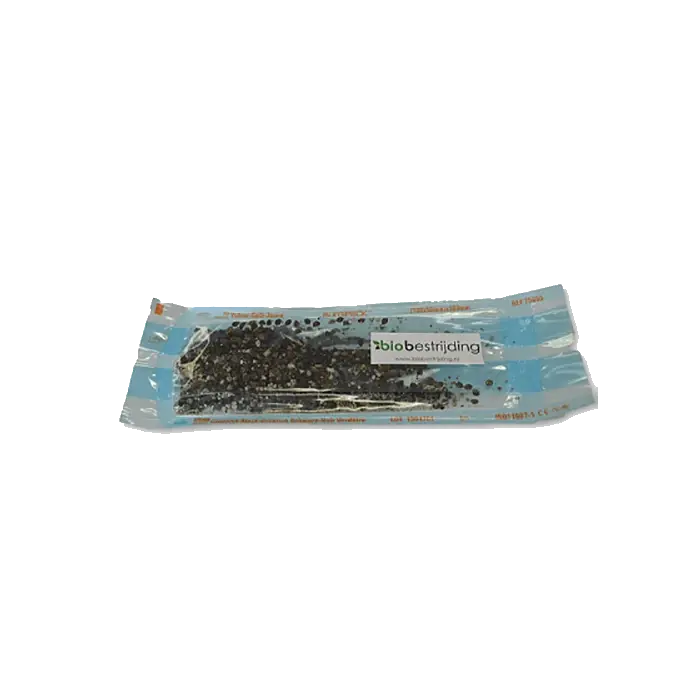BioBestrijding | Predatory Mite Mix against Spider mites ~ 1000 Amblyseius californicus & 500 Phytoseiulus persimilis
BioBestrijding Predator-Mix against Spider mites
Attention! This product consists of live animals and is only available for order in the Netherlands or Belgium. If you order more than just Bio Fight, there will be an additional charge of € 7.95 due to dropshipping from the supplier.
For a total and long-term control of spider mites, we recommend a mix of the Amblyseius californicus predatory mite and Phytoseiulus persimilis predatory mite. We have these predatory mites in the following packaging:
The mix consists of 1,000 Phytoseiulus persimilis and 500 Amblyseius californicus predatory mites. This is sufficient for 200 m2. The mix is supplied in on a leaf or in sprinkle form containing egg-ready predatory mite females, juveniles and adults.
Fighting Spider Mite with Amblyseius californicus
The Amblyseius californicus can be used for effective and long-term control of all stages of spider mite (including greenhouse spider mite and fruit spider mite). The californicus focuses on all stages of spider mites with preference for the younger stages. In the absence of prey, the A. californicus, unlike the Phytoseiulus, can also survive on the pollen present in the plants. The predatory mite can do without food for a longer period of time and is especially suitable as a preventative against spider mites.
Eggs from the Phytoseiulus hatch in 2-3 days. Development from egg to adult predatory mite is about 5 days at the optimum temperature. At a lower or higher temperature, this can take up to 25 days. During her 35-day life, an adult female lays 60 eggs. The eggs are oval in shape and about 0.3mm long.
What is the Phytoseiulus persimilis
The Phytoseiulus persimilis is a bright red colored predatory mite with high legs and is very mobile. This predatory mite feeds exclusively on spider mites (Tetranychus spp.) And is mainly used when there is already a spider mite infection and is especially suitable as a remedy for spider mites. An adult Phytoseiulus is a real spider mite and eats about 5-25 prey per day in the form of spider eggs / larvae, nymphs and adult spider mites.
An adult female lays 2-3 eggs per day under the right conditions. These eggs are placed on the underside of leaves near spider mites to be controlled. The eggs usually hatch after 1-2 days. The born larva has 6 legs and develops into a voracious young specimen within 1 day. The young specimen then develops into an adult predatory mite between 4 and 10 days (depending on the temperature and humidity). An adult predatory mite lives for about 20 days. During her adult life, a female lays 43 eggs.
The Amblyseius californicus and Phytoseiulus persimilis together form the perfect team for controlling spider mites in your plants. Both fighters can also be ordered separately, click here for the Amblyseius californicus and here for the Phytoseiulus persimilis.
Temperature and Humidity
The optimal temperature is between 20 and 27 degrees with an optimal humidity around 60%.
At temperatures above 30 degrees and humidity below 60% the predatory mites reproduce more slowly than the spider mites. In this situation you should closely monitor the effect of the predatory mites. Spraying the plants several times a day for a short period of time promotes the development and reproduction of predatory mites.
Instructions
- Use the Amblyseius / Phytoseiulus mix preventively or as soon as possible after the first appearance of spider mites.
- Release as soon as possible after receipt, predatory mites cannot be kept.
- Open the packaging and spread the material evenly over the plants. If there is a sapwood fire (concentration of sapwood), make sure to turn the material off close to and around the fire.
- Sometimes eggs or predatory mites can remain in the packaging, it is advisable to leave the packaging in the room for a few more days so that the eggs and predatory mites left behind have the opportunity to take action.
- Repeat the application every 2-4 weeks, depending on the development of the infection.
Storage Advice
Biological control agents are live animals and have a (very) short lifespan and must therefore be introduced into the crop as soon as possible after receipt. Storage can affect quality and can only be done under the conditions indicated below.
- Shelf life: 1-2 days
- Storage temperature: 8-10C
- In the dark and store horizontally
Please note! If you order more than just BioBestrijding, there will be € 7.95 extra charge because of the dropshipping from the supplier.





